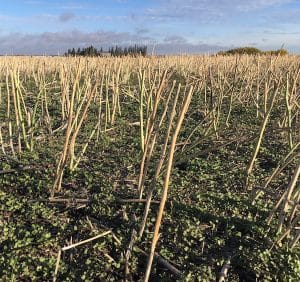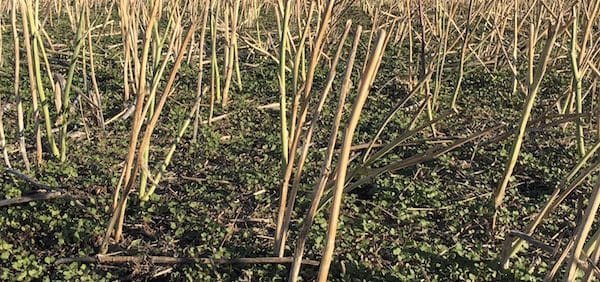The onset of lower temperatures and shortened days in the fall trigger perennials such as Canada thistle, dandelion and quack grass to start moving sugars to below-ground tissues. (Winter annuals and biennial are also doing this, but they don’t need a temperature trigger.) Spraying these weeds in fall takes advantage of this downward flow into the below ground buds on the crown or creeping roots of perennials, providing better control for next year.
Here are some common fall weed management topics:
Frost on weeds. When can I spray? Each weed species has a different tolerance to frost, so rather than focus on how cold it got, the best method is to walk the fields afterward and check for the level of leaf damage. Control can still be obtained if 60% of the original tissue remains green and healthy. Read more.
Cleavers control in the fall. October until freeze up is a good time to control cleavers and other winter annuals such narrow-leaved hawk’s-beard, stork’s-bill and annual sow thistle (common and spiny). That way you get all that have emerged. But check weed staging. Many of the post-harvest product labels have weed staging listed, and winter annuals can hit those stages before October. Apply herbicide when the majority of winter annuals have emerged and are at the right stage for control. Read more.
Timing for perennials. Perennials such as thistles and dandelions are best controlled from mid-September to early October, but may be treated any time after this as long as tissues are healthy and green and weather is warm and sunny. Read more.

Fall management to reduce canola volunteers. The first step in canola volunteer management is to leave seeds undisturbed (i.e. do nothing) so they germinate in the fall or get eaten by birds and insects. This is a good way to reduce the volunteer seedbank. Canola seeds that remain on the soil surface when the snow flies will deteriorate over the winter. If you want to do something, recent research from the University of Manitoba shows that a light pass with harrow after canola harvest stimulates the germination of volunteers and reduces seed bank additions by as much as 50%. Read more.
–A canola regrowth scenario: A farmer in an area of the Prairies that was dry all year has combined his canola, but stems have started reflowering. This is a hormone response as a result of the drought. Some of the lower nodes were dormant but the hormone trigger that usually turns these nodes “off” didn’t kick in. This could be a drought survival mechanism. Whatever the cause, leaves and small branches are growing out of these nodes on the standing stems. Will they take up nutrients and moisture? Will long tangled branches cause issues for the drill next spring? Maybe, but at this stage of the season, regrowth is likely to be minimal and any nutrients taken up will eventually return to the soil. So, if this is the only “weed” issue, it can be safely ignored. Let winter do its killing.
If this field also has perennial or winter annual weeds, using a product or mix that will also control canola volunteers would take care of this regrowth. Farmers have a wide variety of options to clean up this field ahead of cereals.
Further reading:
Fall herbicides for use on fields that will be seeded to canola next spring

